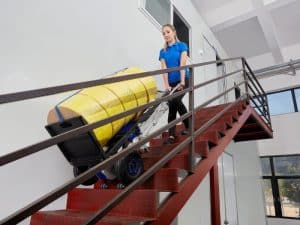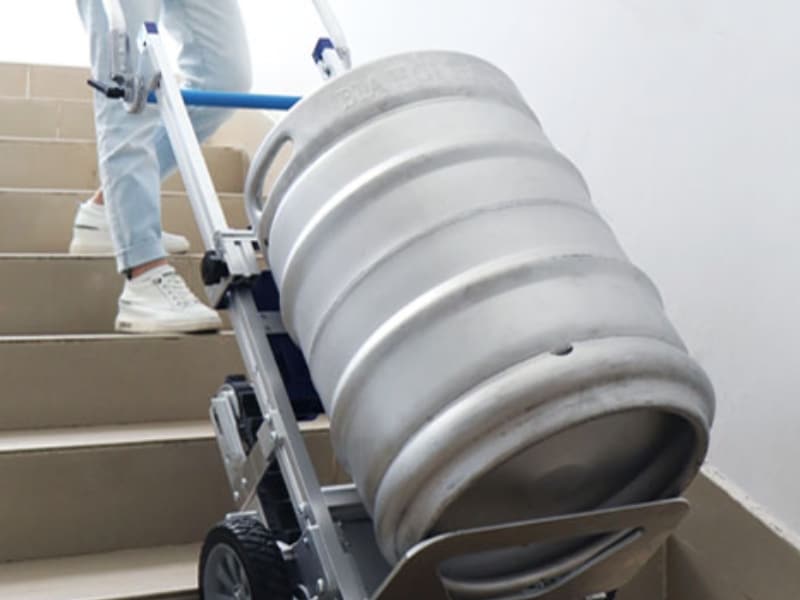Lifting awkward, heavy items by hand isn’t just a pain — it’s a fast track to workplace injury and lost time. Whether you’re in warehousing, deliveries, or event setup, you’ve likely seen how inefficient manual handling can be. A heavy-duty hand trolley isn’t just a convenience — it’s a smarter, safer way to work. This article explores how the right trolley can streamline your tasks, reduce injury risk, and improve long-term productivity.
What problems arise from lifting heavy loads manually?
Manually shifting heavy items might seem straightforward, but it quickly turns risky without the right equipment. The strain on your body builds up over time and can cause serious damage if not addressed.
- Back injuries are a common result of poor lifting habits, especially when bending or twisting under load.
- Manual lifting increases fatigue, which in turn reduces both concentration and accuracy on the job.
- Unexpected slips or drops can damage goods and put coworkers in danger.
- The physical stress of repeated heavy lifting can shorten your career and affect your overall well-being.
Instead of pushing through with physical effort, you need tools that work with your body, not against it. For materials handling, discover reliable hand trolleys designed to handle heavy loads, reducing strain while maintaining a smooth workflow.
Why does poor handling of equipment increase injury risks?
Even with the right tools, poor technique or the wrong equipment can create just as many problems as no equipment at all. Safety doesn’t end at owning a trolley — it begins there.
- Using a trolley with loose wheels or poor balance can lead to awkward turns and tipping hazards.
- Handling loads with the wrong centre of gravity puts unnecessary force on your joints.
- Rushed or careless use of gear often results in sudden jolts, which increase the chance of acute injury.
- Inadequate maintenance allows wear and tear to occur unnoticed, eventually leading to failures.
Every piece of gear demands proper use and regular inspection. Faulty handling isn’t just about technique — it’s also about keeping your equipment in shape.
Could your current trolley be slowing you down?
Not all trolleys are created equal. A basic hand trolley may suffice for light jobs, but once you’re hauling serious weight, delays and strain add up fast. Sometimes the problem isn’t your workload — it’s your wheels.
- Low-capacity trolleys buckle under heavier materials, forcing multiple trips.
- Narrow bases can’t accommodate awkward or oversized items without extra effort.
- Worn tyres and rusty joints reduce rolling efficiency and increase friction.
- No-brake designs may create hazards on inclines or loading ramps.
If you’re losing time, it’s worth checking whether Outdated equipment may be slowing your operations. In fact, these signs your hand trolley needs replacement often show up well before failure — if you know where to look.
How can a heavy-duty hand trolley improve safety at work?
A quality trolley does more than move gear — it’s a safeguard. When designed right, it becomes a physical extension of your safe working habits.
- Wider wheelbases and sturdy platforms enhance balance and reduce the risk of tipping.
- Pneumatic tyres or stair-climbing wheels absorb shocks, making handling smoother.
- Stronger frames carry heavy loads without shifting or collapsing under pressure.
- Features such as built-in brakes, foldable arms, and safety grips help reduce misuse.
By relying on proper equipment, you reduce the chance of injuries and avoid overexertion. And in high-traffic areas, predictable handling means fewer unexpected snags. That’s why the importance of selecting suitable trolleys for tasks can’t be understated — the right tool makes every move safer and more stable.
What should you consider when buying a heavy-duty hand trolley?
Not every heavy-duty trolley suits every job. Understanding your day-to-day needs makes all the difference when choosing equipment that lasts and performs.
Features | Why It Matters |
Load capacity | Prevents frame stress and wheel damage |
Wheel type | Matches terrain for smooth transport |
Frame material | Impacts strength and rust resistance |
Handle design | Affects control and posture |
Folding or fixed structure | Balances mobility with load security |
- A trolley rated for higher loads avoids bending or snapping under strain, protecting both your gear and your team.
- Selecting the right wheel material ensures stability on ramps, gravel, tiles or carpeted areas.
- Lightweight aluminium may suffice indoors, but steel frames are ideal for outdoor or rugged tasks.
- Ergonomic handles enhance steering and reduce wrist fatigue during extended shifts.
When selecting your next trolley, consider factors beyond capacity alone. Prioritise durability, stability, and adaptability to your workplace layout. A narrow design may be easier to store, but broader frames offer more control and load security.
Which tasks benefit most from using a heavy-duty hand trolley?
Not every workplace task needs a tank of a trolley — but some do. For roles where lifting is a constant requirement, a high-quality trolley proves its worth daily.
- Warehouse pickers shifting bulk stock across long distances reduce both load time and injury risk.
- Event crews loading heavy gear into tight or elevated venues benefit from stair-climbing wheels and stable platforms.
- Tradespeople handling materials at height or across uneven ground need extra grip and load security.
- Delivery drivers managing awkward loads upstairs or into lifts gain efficiency with strong, manoeuvrable designs.
Each of these tasks benefits from strength and reliability. Avoiding common hand trolley safety mistakes helps keep workflows safe and efficient, especially when conditions change rapidly on the job.
What is the long-term value of using a heavy-duty hand trolley?
Cost-cutting on tools might save a few bucks upfront, but poor gear ends up costing more in the long run. Reliable trolleys pay off by protecting both your time and your team.
- Reduced downtime from equipment failure saves money and keeps schedules tight. Fewer disruptions mean a more predictable day.
- Less physical strain cuts sick days and physio bills. Safer gear leads to healthier staff and less churn.
- Faster loading and unloading frees up hours every week. This gives your team more time to focus on core tasks.
- Better gear supports safe habits, thereby reducing the risk of long-term injuries. Workers who feel protected also feel more valued — and perform better.
When your trolley performs day in and day out without breaking down or holding you back, it becomes more than a tool — it’s part of the job’s rhythm. That’s why many businesses invest in durable, high-capacity designs to keep their teams moving forward without hiccups.
Final thoughts
Workplace efficiency starts with the right equipment. If you’re still wrestling with outdated trolleys or managing loads by hand, the impact builds over time — on your body, your schedule, and your safety record. For smart, adaptable gear that fits how Aussies work, take a look at how Stair Climbers can support your needs.


